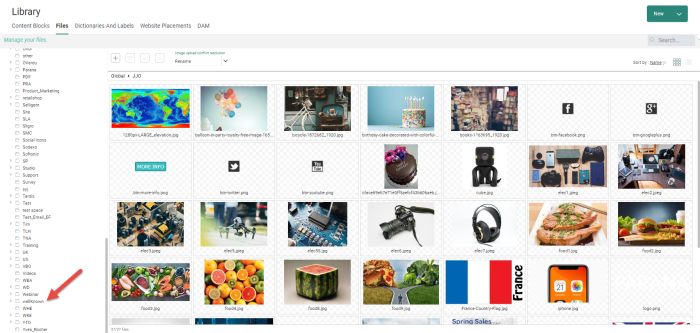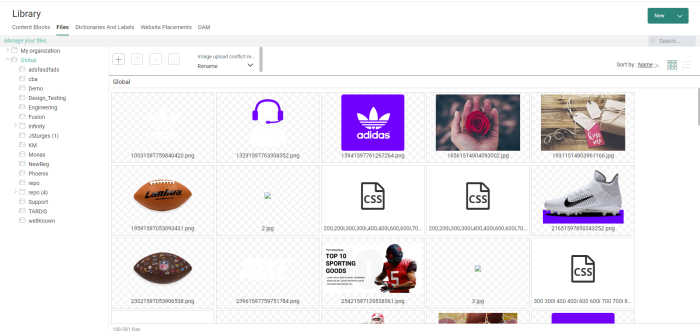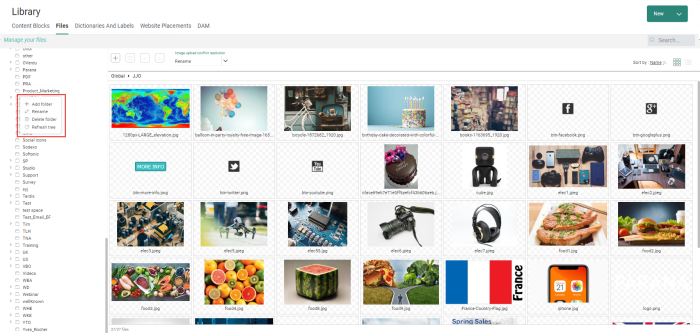The Library contains a tree view of folders on the left and a tile or detail representation of the files on the right. Toggle between both views with the List/Tile buttons at the upper right:
By default, there are two root folders:
- My Organization — This folder allows you to store files in the library, and make these files only available to users of the organization in which the files where added to this folder.
- Global — All images stored in this folder or any sub-folder will be available for everyone.
Example: Users of the Parana organization can add files to this folder. These images will then be linked to the Parana organization only. These files will not be visible to users of the ACME organization.
Managing files
The following operations can be performed on files:
- Select multiple files by holding down the CTRL button while clicking on the files.
- Add — To add a new file to a folder, there are several ways. An upload status dialog shows the status of the upload process. You can:
- Drag a file from a network folder onto a folder in the tree view.
- Open the folder of your choice and drag a file onto the central part of the window.
- Use the 'Add+' button in the toolbar and select the file from the explorer.
- Create — Lets you create new folders and sub-folders to organize the files.
- Delete — Deletes the selected files.
- Clear selection — Deselects all of the selected files.
Moreover, when uploading new files to the library, you can define what needs to happen in case of conflict:
- Rename — Rename the imported file.
- Overwrite — Overwrite the existing file in the library with the new one.
- Keep existing — Keep the existing file in the library and don't import the new one.
Files can be sorted, ascending or descending, using one of the following fields: Name, Size, Extensions or Modified date.
Note 1: It is advised not to change the folder structure, the file name or folder name for files that are already used in content. If any changes are made to existing files, you need to update all content that uses that file.
Note 2: Supported file types are all image file types, JS files and CSS files, and PDF and TXT files and the following font file types: eot, ttf, woff, woff2, svg.
Note 3: Inside the "Global" folder, a "wellKnown" folder is available by default.
You can upload files in this folder, as with any other folder.
This will make those 'well-known' files available on your domain, so that for example when a click is done in a Marigold Engage email that leads to your app, the file is accessible.
More information about the well-known URI can be found here : https://en.wikipedia.org/wiki/Well-known_URI
Managing folders
In the Manage your files panel on the left, you can right-click to see a menu of operations you can perform on the folders:
- Add folder — Creates a new folder. An entry is added to the tree and you can assign it a name.
- Delete folder — Deletes the selected folder. You will be prompted for confirmation before it is deleted.
Note: If a folder is deleted, all images in the folder are deleted as well.
- Rename — Lets you rename the folder.
- Refresh tree — Refreshes the screen to show the most current list of folders.
Technical Note: Because these folder names might be used in a URL, only some special characters are allowed in the folder names: decimal digits, hyphen (-), period (.) and underscore (_)
Note: For performance reasons, when lots of images (e.g., several thousands) are stored in the library, it is advised to create and structure these images in different folders.


